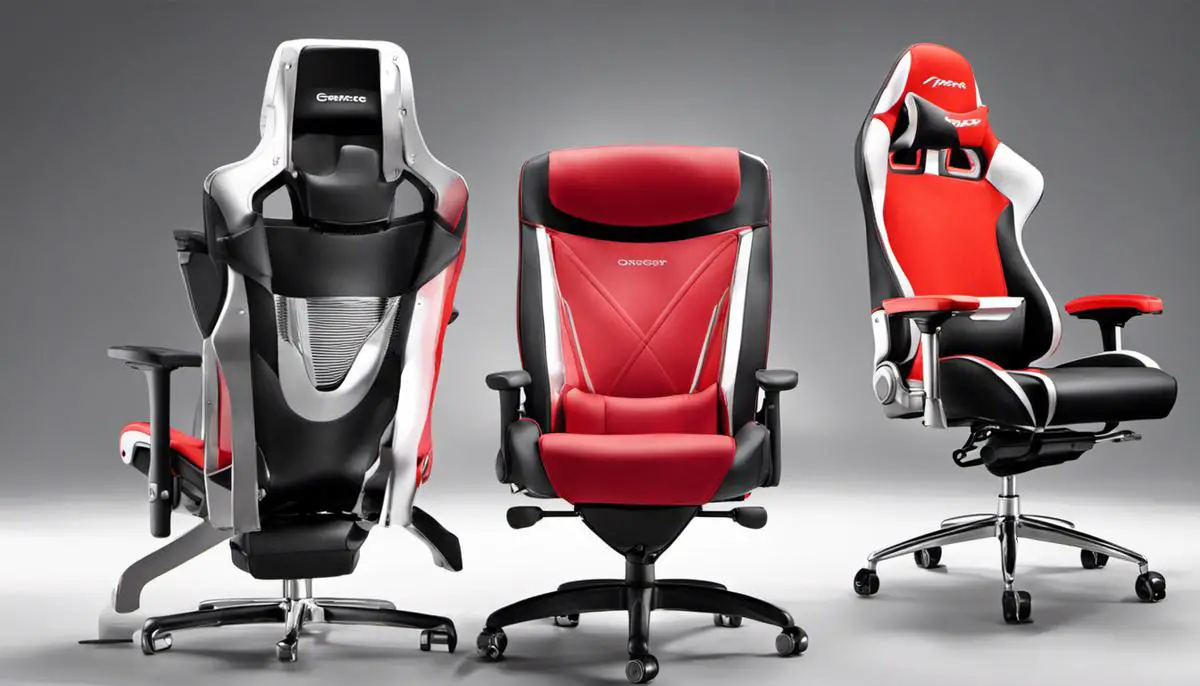Gaming Chair vs Office Chair: A Tech buffs perspective
Uncover the differences: gaming chair vs office chair. Discover which is best for your gaming or work setup.
It’s not uncommon for both gamers and office workers to grapple with the question of which chair type offers the most benefits; A swanky gaming chair or a sophisticated office chair?
With the advent of work from home and home entertainment reaching new peaks, selecting a suitable chair that caters to both professional and gaming needs is crucial.
In an attempt to demystify this dilemma, our discussion explores the nitty-gritty of gaming chairs as opposed to office chairs, analyse their costs, the problems they solve, the technological advancements each has integrated, and finally the user experience unfolded by both chair types.
This examination should help you make an informed decision next time you have to choose between a gaming chair or an office chair.
Characteristics of Gaming Chairs vs Office Chairs
A Comparative Analysis: Gaming Chairs vs Office Chairs
Encounter the battle of comfort and ergonomics as two chair commercial domains, Gaming Chairs and Office Chairs, face off. In recent times, the distinction between these two has been immensely blurring, with many assuming they are interchangeable.
Yet, for the tech enthusiast and avid gamer, it’s worth diving into the details so as to select the perfect chair that offers the ultimate satisfaction and aligns with its specific roles.
Firstly, gaming chairs show off a high-back design that’s inspired by racing car seats. Unlike office chairs, they are constructed to support the back, shoulders, neck, and head – all essential for long gaming sessions.
Many gaming chairs boast removable cushions for extra comfort and adjustable armrests, which grant an ideal position for joystick or keyboard handling.
Office chairs, on the other hand, are designed with extended hours of work in mind. Built for ergonomic support and comfort during rigorous typing and mouse use, office chairs focus on maintaining good posture, ensuring comfort, and reducing the risk of carpal tunnel syndrome. They typically feature a more subdued look as opposed to the flashy aesthetics seen in gaming chairs.
Design and aesthetics pose a significant divergence as well. Gaming chairs often sport a bold, aggressive design and are available in a spectrum of flashy colors that resonate with the vibrant nature of gaming interfaces. Office chairs are more conservative, emphasizing functionality over visual appeal and blending seamlessly with professional environments.
On the aspect of adjustability, gaming chairs and office chairs are pretty neck-and-neck. Both allow for height adjustments and customization options. Gaming chairs usually provide more comprehensive adjustments, like 180-degree recline for a quick power nap between gaming sessions. In comparison, office chairs offer more nuanced mechanisms to support an array of working positions due to their precise lumbar support systems.
When it comes to material, gaming chairs typically utilize PU leather for being resilient, easy to clean, and because it offers a sleek, sophisticated look. Office chairs, meanwhile, often elect mesh fabric for better breathability and thermal regulation, crucial for maintaining focus and comfort throughout an eight-hour workday.
In summary, gaming chairs channel a zest for life, embodying the thrills of gaming with their high-back design, bold colors, and adjustable features that cater to the gamer’s comfort. Office chairs cater to the disciplined worker, providing ergonomic support, subtle aesthetics, and nuanced customization to get through a productive workday.
Choosing between the two isn’t merely about picking a chair, but about deciding which chair best echoes your needs, purpose, and aesthetic preferences. Both exuberantly celebrate technological advancements in their own rights. They showcase how technology does not just refer to robotic automation or out-of-this-world gizmos, but to everyday products designed with human comfort and productivity in mind. With gaming chairs and office chairs, technology becomes a tangible everyday experience.

Problems Addressed by Both Chair Types
Common Issues Addressed by Gaming and Office Chairs
As technology advances and digital expression expands, innovations in our everyday surroundings become imminent. One such area of ground-breaking progress is seen in the realm of seating solutions, especially ergonomic gaming and office chairs.
Among a plethora of these innovative features lie the pivotal distinctions – each addressing common issues and delivering unique solutions.
A key issue that these chairs endeavor to solve is ensuring a conducive environment for extended use. Simple, you may think? Yet, many conventional seating options fail to grasp the longevity factor, leading to unhealthy postures and a slew of associated problems.
Gaming chairs, with their distinctive high-back design and removable cushions, along with adjustable armrests, tackle this predicament head-on. Similarly, office chairs, focusing on ergonomic support, aim to enhance comfort during long work hours.
The factor of aesthetics also needs addressing. In a world becoming increasingly conscious of visual appeal, a chair is more than a seating apparatus – it becomes an extension of the user’s personality.
Here’s where gaming chairs score, with their vibrant colors, bold and aggressive designs. On the flip side, office chairs, in their bid to fit into a professional setting, adopt a conservative, functional design.
Customizability is another focal point. Humans are not built in a one-size-fits-all structure. We have distinct physical attributes and personal preferences, all of which require accommodation. The ‘height adjustments’ and ‘recline options’ of gaming chairs and the customization capabilities of office chairs – all underscore the importance of physical diversity, showcasing technological prowess committed to comfort and productivity.
When observing material choices, one cannot disregard the PU leather used by gaming chairs and mesh fabric found in office chairs. Why material matters, you may ask? It directly impacts comfort, durability, and overall user experience. More importantly, material choice greatly affects a chair’s performance in heat dissipation – an important consideration during extended usage.
In conclusion, whether one chooses a gaming chair or an office chair comes down to individual needs, purpose, and aesthetic preference. From design variants to functional differences, each offers unique solutions to common issues. The gaming chair vs office chair debate is an ongoing one – with each side armed with its distinguishing features and innovative tech. Ultimately, these seating solutions exemplify a blend of technology and comfort, beautifully woven together and tailored to meet the demands of a dynamic digital age.

Cost-Effectiveness Analysis
In delving deeper into the financial implications of choosing a gaming chair over an office chair, beyond the upfront cost, several vital aspects emerge as significant determinants. These points largely swirl around the lifespan, wear and tear, and maintenance measures of these two types of chairs.
On the life expectancy front, gaming chairs have a notable edge over office chairs, owing to the robustness of construction materials utilized in their manufacturing. Predominantly crafted with heavy-duty steel frames and high-density foam, gaming chairs often outlast their office counterparts, resulting in a value-for-money proposition in the long run. It’s a classic case of investing more initially but spending less in terms of replacements or extensive repairs over time.
Furthermore, gaming chairs usually boast a sophisticated mechanism for enhanced durability, further complementing their long lifespan characteristics. From metal base plates to class-4 gas lifts, these chairs’ components are developed for high-durability and can withstand excessive usage without malfunctioning.
In terms of wear and tear, the rigorous use of chairs, especially in a gaming or work-from-home set-up, propounds the necessity of material carefully chosen with longevity in mind. Gaming chairs tend to use PU leather, which, despite criticism for breathability issues, ranks high for its resilience against spills, physical damage, and cleaning routine, presuming less replacement cost in future.
Consistent with the wear and tear concept is the understanding of maintenance implications. While both gaming and office chairs require upkeep, gaming chairs offer ease with their predominantly leather-based upholstery. Thus, they are less prone to stains and much simpler to clean than the often fabric-based office chairs. Easy and less frequent maintenance reduces not only the time but also the resources invested, portraying an economic advantage.
Finally, the impact of warranties enlisted by manufacturers holds importance when deliberating on cost as well. Gaming chairs generally come with extended warranties, safeguarding users against potential defects and damages. Considering warranties can save on potential repair or replacement expenses, the value offered by extended warranties often justifies the initially higher expenditure on a gaming chair.
Ultimately, the decision to choose between a gaming chair and an office chair goes beyond merely considering the upfront cost. It’s an amalgamation of factors such as durability, wear and tear resistance, maintenance needs, and warranty coverage that dictate their financial implications in the long haul.

Tech Innovations in Chair Design
As the world continues to digitize, the line between the digital and physical realm continues to blur. This trend is also prevalent in the world of chairs, where technology continues to greatly influence the design and functionality of gaming and office chairs.
In contemporary chair engineering, technology has ushered in an era of smart chairs. These high-tech creations integrate sensors, monitor users’ sitting habits, and make automatic adjustments to complement the body’s natural movements. In essence, these chairs adapt to the user rather than the user adapting to them. For instance, they can monitor the user’s posture and procures an alert ‘dings’ during hunching. While these smart chairs are still at the high end of the market, more affordable options with similar principles are starting to emerge.
Meanwhile, on the gaming side, chairs with built-in speakers, vibration, and other immersive features have become increasingly popular. Imagine a chair rumbling every time there’s an explosion on the screen or music beating directly into one’s back. Such chairs provide an unparalleled gaming experience that enhances the feeling of being “in the game.” The increase in virtual reality gaming also fuels this trend, pushing the limits of what we deem as ‘gaming chairs.’ Some companies have started developing full-body haptic feedback systems that integrate into chairs, offering an unprecedented level of immersion for gamers.
Furthermore, in both office and gaming chairs, built-in heating and cooling systems are becoming increasingly common, providing the user with optimal thermal comfort. Designed with technology that can adjust the chair’s surface temperature, these systems mitigate one of the longstanding issues of sitting for prolonged periods.
Lighting has also made its way into chair design, particularly gaming chairs, adding an extra layer of aesthetic appeal. These range from simple underlight features that often match other illuminated gaming peripherals, through to intricate designs that integrate directly into the fabric of the chair itself.
While these are exciting developments, one must not overlook the issue of sustainability and how it increasingly drives the design and production of both gaming and office chairs. Innovative materials such as recyclable plastics, plant-based fibers, and other environmentally-friendly options have begun to see use in chair production. Further, many manufacturers are making conscious efforts to ensure their supply chains, manufacturing processes, and end products adhere to modern sustainability standards.
In conclusion, technological advancements have not only made chairs more comfortable but have also enhanced their functionality and broadened their efficiencies beyond the traditional scope. It’s an exciting time for chair technology, and who knows what the future holds for the humble chair. As manufacturers continue to innovate, integrating more sophisticated technology, it’s clear that the evolution of the chair is far from complete.

User Experience: Gaming Chair vs Office Chair
Most importantly, the invasion of technology into our lifestyle has blurred the line between the digital and physical domain. This trend has impacted all aspects of our lives, including seating solutions. Chairs have emerged from being just furniture to tech devices festooned with varied functionalities. The question, however, that causes a furrowed brow among technophiles is how these tech-driven advancements in chairs significantly alter user experiences.
An incredible innovation of smart chairs is the inclusion of adaptive tech. These chairs, both gaming and office, efficiently intuit user’s sitting habits and adapt accordingly, ensuring the utmost comfort during extended use. Interestingly, the price point for these smart chairs is gradually becoming affordable, bringing them within the reach of many.
Gaming chairs are rocketing up the charts with some incredible integrated features such as built-in speakers, tactile vibration, and immersive haptic feedback system. As the gaming industry garners popularity, gamers are increasingly appreciating these features to enhance their virtual reality experiences. Full-body haptic feedback in gaming chairs is ‘the game changer,’ making users feel gaming actions in a real, physical form, thereby transcendentally lifting their adrenaline rush.
Office chairs are not lagging in the race, with a few brands incorporating thermal comfort systems. Built-in heating and cooling module in office chairs accentuates user comfort, reducing fatigue and promoting productivity. These thermal solutions are ideal for those find managing their body temperature a difficult proposition during long sittings.
Design and aesthetics, doubtlessly, play a pivotal role in chair purchases. Gaming chair manufacturers are integrating lighting functionalities, enhancing their visual appeal. These chairs, when synced with in-game lighting effects, can submerge users into another world, augmenting their overall gaming experience.
Focusing down the road, sustainability is undoubtedly where the future is heading. Chair manufacturers are increasingly becoming aware of the environmental ramifications and hence amalgamating sustainability considerations into their production process. This push is spawning the use of innovative materials and consistently adhering to sustainability standards; a commendable shift, highlighting the blend of technology, comfort, and consciousness.
While these technological developments are pacing exponentially, the future holds a bouquet of more dramatic advancements. Imagine having AI-powered chairs which can identify your discomfort through periodic gestures and adjust automatically to ensure ideal seating posture. Or how about health monitoring chairs that detect irregular body parameters, stress levels, and suggest possible remedies? These substantial technological footsteps can lead to an orchestration of the digital world with the physical realm, improving the future seating experience beyond imagination.
In conclusion, delving into the gaming chair versus office chair debate, one can infer that user experiences are radically transforming due to technology interventions. From adaptive technologies to immersive gaming experiences, thermal management to aesthetic lighting, all aspects are converging to uplift user satisfaction levels. Although the optimal choice between a gaming chair and an office chair will always hinge on individual needs, purposes, and aesthetics, there’s no denying the pulsating influence technology has on chair design and manufacture. By all indices, this fascinating convergence of design, technology, and comfort is all set to revolutionize the way we perceive and experience seating solutions.

There’s no one-size-fits-all answer when it comes to the gaming chair and office chair contest.
Both types of chairs carry their unique merits, features, and experience, heavily influenced by the target user’s preferences, type of usage, budget, and individual ergonomic needs.
Where gaming chairs enthral with their aesthetics, adjustability, and comfort designed for prolonged use, office chairs have their forte in minimalistic design, professional appeal, and diverse price range.
All variables considered – cost-effectiveness, problem-solving abilities, tech integrations, and user experience, it boils down to the balance struck between the specific needs and the chair’s delivered value.
This understanding serves the foundation for making an informed choice on which chair suits your specific lifestyle or workspace needs better.






